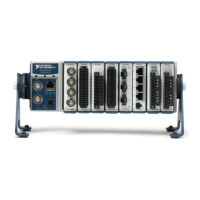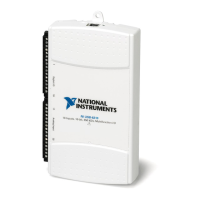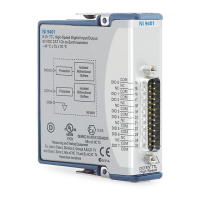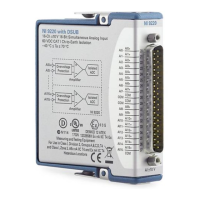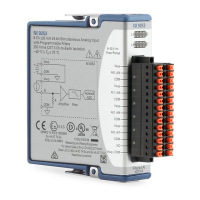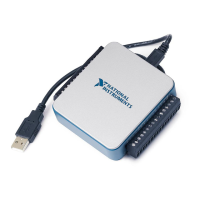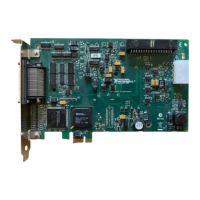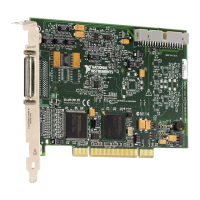Chapter 5 Analog Output
X Series User Manual 5-4 ni.com
operations are optimized for low latency and low jitter. In addition,
HWTSP can notify software if it falls behind hardware. These features
make HWTSP ideal for real time control applications. HWTSP
operations, in conjunction with the wait for next sample clock
function, provide tight synchronization between the software layer and
the hardware layer. Refer to the NI Developer Zone document,
NI-DAQmx Hardware-Timed Single Point Lateness Checking, for
more information. To access this document, go to
ni.com/info and
enter the Info Code
daqhwtsp.
Note (NI USB-634x/635x/636x Devices) X Series USB devices do not support
hardware-timed single point (HWTSP) operations.
• Buffered—In a buffered generation, data is moved from a PC buffer to
the DAQ device’s onboard FIFO using DMA before it is written to the
DACs one sample at a time. Buffered generation typically allow for
much faster transfer rates than non-buffered acquisitions because data
is moved in large blocks, rather than one point at a time.
One property of buffered I/O operations is the sample mode. The
sample mode can be either finite or continuous:
– Finite sample mode generation refers to the generation of a
specific, predetermined number of data samples. Once the
specified number of samples has been written out, the generation
stops.
– Continuous generation refers to the generation of an unspecified
number of samples. Instead of generating a set number of data
samples and stopping, a continuous generation continues until you
stop the operation. There are several different methods of
continuous generation that control what data is written. These
methods are regeneration, FIFO regeneration and
non-regeneration modes:
• Regeneration is the repetition of the data that is already in the
buffer. Standard regeneration is when data from the PC buffer
is continually downloaded to the FIFO to be written out. New
data can be written to the PC buffer at any time without
disrupting the output. Use the NI-DAQmx write property
RegenMode to allow (or not allow) regeneration. The
NI-DAQmx default is to allow regeneration.
•
Wit
h FIFO regeneration, the entire buffer is downloaded to
the FIFO and regenerated from there. Once the data is
downloaded, new data cannot be written to the FIFO. To use
FIFO regeneration, the entire buffer must fit within the FIFO
Artisan Technology Group - Quality Instrumentation ... Guaranteed | (888) 88-SOURCE | www.artisantg.com
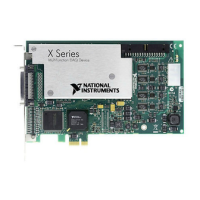
